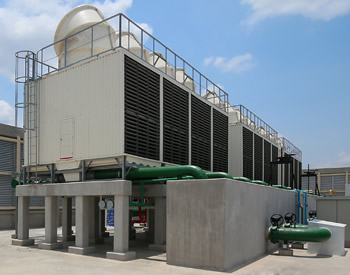7 Water Saving Measures for Cooling Towers

Cooling towers use lots of water. Given that their purpose is to dissipate heat from recirculating water used to cool air conditioners, that fact is hardly a surprise. All this evaporative water loss, however, is wasteful and expensive.
Cooling tower efficiency can be improved through proper management of the recirculated water. Here are seven measures an organization can take to maximize cooling tower efficiency and lower water consumption.
- Maximize the cycles of concentration. Cycles of concentration is the number of times a tower recycles water before it needs to be dumped; it’s also known as blowdown. In other words, it’s the number of times that fresh make-up water can be used in the tower before the dissolved minerals cycle up to the point where they drop out of the solution. A cycle of concentration of three is generally considered minimum efficiency.The actual number of cycles a cooling tower system can handle depends on the quality of the make-up water and the water treatment regiment. Significant strides are being made in treatment systems that monitor and minimize chemical use. They reduce the potential for corrosion, scaling and biological growth, while allowing towers to operate safely at higher concentration ratios. Increasing cycles from three to six, for instance, reduces cooling tower make-up water by 20% and cooling tower blowdown by 50%. In many parts of the country, much higher cycles of concentration are possible. You should work with your water treatment vendor or local government agencies to determine the right number.
- Reduce blowdown through careful monitoring and agreed-upon set points. In an attempt to minimize scaling and biological growth, many operators increase blowdown water, which causes water loss. This action, however, can also increase corrosion by lowering the pH. Careful monitoring, establishing and adhering to set points and installing a conductivity meter (see #3) can help reduce water waste. You’ll also reduce sewage, another potentially significant cost savings.
- Install a conductivity controller to automatically control blowdown. Conductivity is a measure of water’s ability to conduct electricity. In cooling water, it indicates the amount of dissolved minerals in the water. As the name implies, a conductivity meter or controller continuously measures the conductivity and discharges water only when the conductivity set point is exceeded.
- Install flow meters on make-up and blowdown lines. Check the ratio of make-up flow to blowdown flow. Then check the ratio of conductivity of blowdown water and the make-up water. The ratios should match the target cycles of concentration. If both ratios are not about the same, check the tower for leaks or other unauthorized draw-off. If the system is not operating at, or near, your target cycles of concentration, check system components including conductivity controller, make-up water fill valve and blowdown valve. Keep track of make-up and blowdown quantities, conductivity and cycles of concentration so you’re able to see any performance degradation.
- Monitor water levels. Consider switching away from ballcock-style fill valves that are prone to leakage and frequently get out of adjustment to more reliable fill valves. An additional source of water loss may be when the fill level is set too high. In such cases, strong airflow in the sump can cause choppiness on the water surface and water overflow. The water level in the sump should be regularly checked to ensure it is adequately below the overflow outlet to avoid excessive water use.
- Keep air handler coils well maintained. As coils become dirty or fouled, the load increases on the chilled water system as it tries to maintain conditioned air set point temperatures. The additional load not only increases the use of electricity, it taxes the evaporative cooling process, thereby using more water.
- Carefully select your water treatment vendor based on their commitment to water conservation. Make sure your selected vendor understands that water efficiency is a priority, and that they have a solid reputation of results in this area. Not every vendor wants to service a conservation-oriented client as that usually means selling fewer chemicals (savings on chemicals is an indirect and not insignificant additional benefit of water conservation). A water treatment vendor should be selected based on the cost to treat make-up water and maintaining a cooling tower to the highest recommended system water cycle of concentration.
These are just a few ways in which you can reduce water loss from your cooling tower system. You should also consider a leak detection and monitoring system such as WaterCompass from HydroPoint. WaterCompass provides the visibility and analytics needed to detect leaks and monitor water usage both indoors and out. It tracks cooling tower performance and saves time by automating a largely manual process. You can track make-up, make-up to blowdown ratio, cost, cycle of concentration and number of alert days, and compare results across several cooling towers.
Let us help you with smart water management for your cooling tower, complete the form at the right, and one of our associates will be in touch.
Ready to stop wasting water? Our team of experts have you covered with the best tools in the industry.

